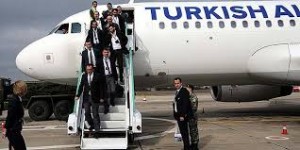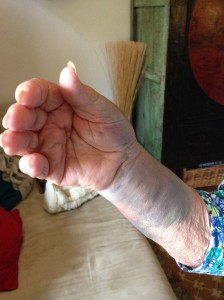Its 00.15 on Monday morning and Turkish Airlines flight TK0898 from Istanbul Sabiha Gokcen International Airport has arrived on stand 20 minutes late in swirling snow at Tehran Imam Khomeini International Airport. To be fair the journey which started at London Gatwick at 11.55 on Sunday has been very good but with a busy day ahead, and a 60  minute drive to Hotel Niloo, the chances of being in bed much before 2am are receeding. Then events take a turn for the worse!
minute drive to Hotel Niloo, the chances of being in bed much before 2am are receeding. Then events take a turn for the worse!
The steps to dissembark have a fault and it will be a further 20 minutes before an alternative is delivered to offload a plane load of very grumpy passengers many of whom are Europeans on the first visit to Iran.
Fortunately I am at the front of the plane so able to converse with the Cabin Cheif. She is looking at the manual of useful information to give passengers during the flight and there is no entry to cover this situation. So she declines to make a comment while passengers fulminate. It could have all been so different!
I am a great fan of checklists believing them to be knowledge enabled documents which should be, if they are regularly updated, the best practices of an organisation. And as I was to suggest during my client visit the best way to bring about a change in checklists often starts with an After Action Review (AAR) or a Learning Review.
I know organisations where after an event (like the end of a flight) the team would have held a quick debrief using the AAR template:
- What was supposed to happen;
- What did happen;
- Why was there a difference:
- What can we learn from this;
- What can we do better next time;
- What actions should we take; and
- Can we celebrate success?
The AAR session would have surfaced all the issues about the lack of communication and (maybe) occasioned a change in operating procedures and their checklist – encouraging the cabin staff to keep people updated when things go wrong!
This is where the true value of tools such as AAR come in, they are precursors to a change in procedures or checklists. Many organisations’ Knowledge Management (KM) activity culmiates in the share and reuse step. I have come to realise while working alongside Ron Young and Knowledge Associates that the true value of KM comes from the step of Harvesting which involves turning what has been collected into learning’s and proposed process improvements which the process owner and subject matter experts review and accept or reject. Checklists then get updated (or not) at that point and the organisation learns from doing!
Lessons Learned when ‘my knowledge is my soul’
For the Harvesting step to work effectively though there has to be an environment that recognises and values the process of capturing and building on learning’s from such tools as AAR. Too often this process throws up dozens of action points few of which get actioned. If you can’t count the actions on the fingers of one hand its unlikely anything will happen as a result.
A few years ago in Khartoum I was to discover that knowledge has a more spiritual feel/meaning in the Arabic and Farsi speaking world. ‘My knowledge is my soul’ is a good indicator of how personal knowledge is viewed and this (taken from a corporate Code of Ethics booklet) reinforces the view that a purely Western approach to the use of tools such as After Action Reviews, Lessons Learned Workshops and Pause & Reflect sessions will not work:
We believe the ethical confrontation with failures should be through awareness, consultation giving the subordinates the opportunity to rectify and compensate for mistakes and applicaton of regulations fairly,,,
So what will? Perhaps this gives an insight.
The Wrestler’s story
During my recent trip to Iran I was taken to the landmark Milad Tower. Around the viewing gallery are a collection of silicon ‘wax’ works of some of Iran’s most famous and loved figures. There are many poets, writers, a few politicians and one sportsman:

Gholamreza Takhti
Gholamreza Takhti is one of the most, if not the most, loved sportsman in Iran. Here’s why: Takhti tended to act fairly when competing against rivals during his career, something which originated from traditional values of Zurkhaneh, a kind of heroic behaviour that epitomizes chivalrous qualities known as Javanmardi.
For instance, once he had a match with Russian wrestler Alexander Medved who had an injured right knee. When Takhti found out that Medved was injured, he avoided touching the injured leg and tried to attack the other leg instead. He lost the match, but showed that he valued honorable behavior more than reaching victory.
This act of chivalry and exceptional sportsmanship is seen as the desired way to behave and permeates a lot of business dealings.
And finally
Effective Knowledge Management relies on effective Personal Knowledge Management. Appealing to the corporate good and the team ethic is not going to win supporters or make people feel individually empowered.
Addressing the ‘What’s in it for me?’ question is vital: this is not purely about money but also recognition, self esteem and personal development. It’s one reason why many senior corporate positions are filled by academics and people value certification as a way of demonstrating knowledge and expertise.
On the downside it can breed a culture of learning but not necessarily doing: ‘if I am to be punished for making a mistake then why would I try to do it in the first place and I certainly won’t acknowledge it afterwards.’
While we in the West think its quite natural to have an open and frank dialogue about what we could do better next time, its not always the case elsewhere. Our challenge is to find a way to surface learning’s and build them back into process while recognising its counter culture in a personal risk averse environment.


